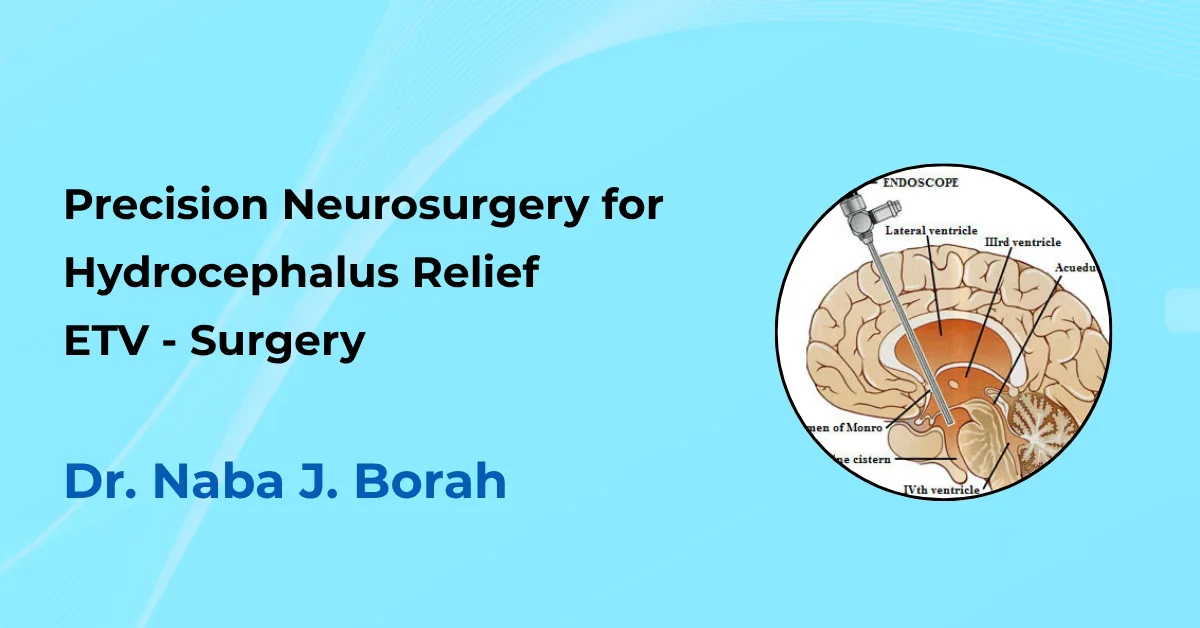
Hydrocephalus, often referred to as “water on the brain,” is a neurological condition marked by abnormal accumulation of cerebrospinal fluid (CSF) within the ventricles of the brain. If left untreated, it can lead to increased intracranial pressure, developmental delays, cognitive impairment, and even life-threatening complications.
One of the most effective and minimally invasive surgical options for managing obstructive (non-communicating) hydrocephalus is Endoscopic Third Ventriculostomy (ETV). At the forefront of performing this advanced procedure in North East India is Dr. Naba J. Borah, a senior neurosurgeon with more than 10,000 successful neurosurgical procedures to his credit.
What Is Endoscopic Third Ventriculostomy?
ETV is a neuroendoscopic procedure designed to restore normal cerebrospinal fluid flow without the need for a shunt. Unlike traditional ventriculoperitoneal (VP) shunt surgeries, which implant a foreign device, ETV creates a bypass route within the brain to allow CSF to exit the blocked ventricular system and be absorbed naturally.
Using a high-resolution neuroendoscope, a small opening is made in the floor of the third ventricle, allowing CSF to flow directly into the basal cisterns, thus bypassing the obstruction.
Clinical Indications for ETV
- Aqueductal stenosis (congenital or acquired)
- Posterior fossa tumors causing CSF blockage
- Failed VP shunt with intact cerebral compliance
- Selected cases of normal pressure hydrocephalus
- Chiari malformation with ventricular enlargement
Dr. Naba J. Borah’s Expertise in ETV
With his current affiliation at Health City Hospital, Guwahati, Dr. Borah brings extensive intraoperative experience and precision in managing complex neuroendoscopic cases. His early tenure at GNRC helped him build foundational expertise in intracranial endoscopy, and over the years, he has refined ETV into a low-risk, high-reward treatment modality in appropriate patient groups.
His meticulous technique ensures minimal brain tissue disruption and reduced postoperative complications. Many of Dr. Borah’s patients have reported faster recovery times, reduced dependency on shunt systems, and long-term CSF flow normalization after undergoing ETV.
Advantages of ETV Over Shunt Surgery
- No foreign implants, reducing risk of infection and malfunction
- Physiological CSF flow restoration
- Lower long-term maintenance compared to shunt systems
- Minimal scarring and shorter hospital stay
- Effective in pediatric and adult patients (with careful selection)
ETV Success Rates and Follow-up
Studies and Dr. Borah’s own clinical outcomes suggest that ETV has a success rate ranging from 70–90%, depending on age, etiology, and ventricular anatomy. Long-term imaging follow-up and neurological assessments are critical to monitor outcomes, and Dr. Borah’s post-op protocols ensure that any signs of failure (e.g., persistent ventriculomegaly or symptoms) are addressed promptly.
Why Choose Dr. Naba J. Borah for ETV in North East India?
- Over 10K+ complex neurosurgical procedures
- Advanced training in neuroendoscopic and minimally invasive neurosurgery
- One of the few neurosurgeons in the region regularly performing ETV
- Emphasis on patient safety, informed consent, and long-term outcomes
Conclusion
ETV represents a paradigm shift in hydrocephalus management—less invasive, more physiological, and highly effective when performed by skilled hands. If you or a loved one is facing hydrocephalus or has undergone repeated shunt revisions, consult Dr. Naba J. Borah to explore the possibility of Endoscopic Third Ventriculostomy.
Contact Dr. Naba J. Borah
📞 Phone: +91-9864516798
💬 WhatsApp: +91-8404061190
📅 Book Appointment: Click Here
Disclaimer:
This article is intended for informational purposes only and should not be used as a substitute for medical advice from a qualified professional. In case of a medical emergency, contact your nearest healthcare provider immediately.
